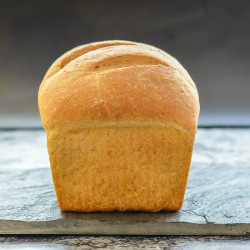To a large bowl or stand mixer add both flours, the yeast, and the salt.
Add the olive oil and the water. Turn on the stand mixer and knead the dough for 7 minutes. My Kitchen Aid manual recommends speed 2 for bread dough. You might need to stop the machine after a couple of minutes and scrape down the sides if it isn't catching all of the flour as it kneads. If it feels a little dry add a few drops more water. Add it very gradually though so you don't accidentally add too much. It should feel slightly tacky but not wet. If you are working by hand, stir the ingredients together with a spatula until a rough dough is made, then turn out onto a clean surface. Don't flour the surface. Instead rub some olive oil on it and on your hands. It will stop any sticking and means there is no chance of you adding too much extra flour which will affect the texture of your bread, making it dry and heavy. Knead for 10 to 15 minutes, until the dough is smooth, elastic. When you squeeze the ball of dough between both of your hands, it should bounce back. If you are unsure how to knead I recommend watching this video to help you perfect your technique.
Once kneaded, grease a large bowl with a little oil, then put the kneaded dough in it and move it around to coat all over in a light coat of oil.
Cover with a damp, clean dish towel ( I run mine under the tap for a minute then wring it out), and leave on the kitchen counter until doubled in size. The time this takes will vary depending on how warm your kitchen is, but bear in mind that the longer it takes to rise, the more flavor there will be in your finished loaf, so unless you are in a hurry, don’t rush it by cranking up the heat or putting it somewhere very warm. Mine generally takes between 60 - 90 minutes to double in a 20°C kitchen.
Once the dough has doubled, scrape it gently onto a clean, lightly oiled work surface.Try not to tear it. Use the heels of your hands to flatten it into a rectangle roughly the width of your bread pan.
Fold the bottom third up and use the heel of your hand to push it down and seal it a bit. Then fold the top third down and push it down to seal it again. Then fold the dough in half again and pinch closed. Watch my video to see these steps. Gently turn under the ends if they look a little untidy then gently place in a lightly oiled bread pan. It will fit well into an 8.5 by 4.5 inch pan or a 9 x 5 inch pan.
Rub a tiny bit of oil over the surface of the dough to stop sticking, then cover again with the damp dish towel and leave again until the bread dough is nicely domed and about 1 inch above the sides of the pan. It won't take as long this time. In my kitchen about 30 minutes.
While you are waiting for your loaf to rise preheat your oven to 400° F (200°C).
Once risen score the top of the loaf with a lame or very sharp knife. A serrated knife works well. If you've got kitchen scissors you can even cut it with those (you can do one long cut all the way down the middle, or several along the width). You can bake it without scoring but accept that the bread will then decide itself where the weak point is and it might split and look a bit unsymetrical and ugly.
Place in the preheated oven and bake for 40 minutes. Slide out of the pan and cool on a cooling rack. You can check it's ready by tapping the loaf on the bottom with your fist as if you are knocking on a door. It should sound hollow.
As hard as it is to resist eating it when fresh out of the oven it really is best to leave it to cool completely before cutting. Cutting while still warm affects the crumb and it will stale more quickly because the cut lets the steam out. You can solve this problem by doubling the recipe and making two loaves. One for eating while warm and one for later!
